
Ãëàâíàÿ
ñòðàíèöà
Ñâåäåíèÿ îá àâòîðàõ
SAFETY MANAGEMENT OF WASTEWATER TREATMENT PLANTS. RELATIONS WITH THE «MAJOR HAZARD INCIDENT» DIRECTIVE
Torretta V., Università` dell’Insubria di Varese, Varese, Italy
Summary
Wastewater treatment plants can generate risk sources
for health, safety and environment, due to the nature of water inlet, the
substances involved and produced by the treatment process. In particular for
chemical risks in wastewater treatment plants, two case studies have been
analyzed in this document:
• the phase of disinfection with Peracetic Acid, used as reactant;
• the phase of anaerobic digestion, generating biogas.
1. Chemical risks in the wastewater treatment plant
1.1. General aspects about the risk definition
The chemical risk is considered as the probability that a release event, a fire
or an explosion (inside or outside the fence of a plant), can generate a serious
hazard (immediate or delayed) to the health, to the assets or to the environment,
due to one or more chemical substances. This risk can be related to all process
that use dangerous chemicals, as gas, vapours, aerosol, liquids or dusts,
included production, handling, storage and discharge operations.
Risk value can be calculated as the product between the occurrence frequency of
an event and the value of gravity (magnitudo) of the damage generated by the
same event: R = F × E (where R — risk; F — occurrence frequency, event/year; E —
damage value, euro/event).
1.2. Risk Analysis Techniques
FMEA and FMECA Methodologies
One of the analysis methodology for the evaluation of a mechanical project is
the FMEA (Failure Mode and Effects Analysis). The execution of FMEA is
related to the analysis of each product, by considering the most probable
failure mode, the occurrence frequency and the effects on surrounding
environment. If a critical analysis for the evaluation of the effects magnitudo
is added, the FMEA becomes FMECA (Failure Mode, Effects and Criticality
Analysis).
HazOp Methodology
HazOp methodology (Hazard and Operability) is an analytic study for the
identification of all factors that generate uncertainty and can relate these
factors with operating anomalies. The HazOp methodology is an interactive and
systematic process.
2. Cases studies
In the cases examined, disinfection phase and biogas
treatment have been considered. Risk analysis has been carried out in order to
identify:
• the kind of accidental events;
• the occurrence frequency of the accidental events;
• the magnitudo of the accidental events.
2.1. Disinfection with the Peracetic acid
Peracetic acid is classified as oxidizer (O, phrase R7), flammable (phrase R10), harmful (Xn, phrases R20/21/22), corrosive (C, phrase R35) and dangerous for the environment (N, phrase R10). The Peracetic storage must be protected from fire. It is necessary also provide for the containment of liquid waste generated by the fire extinguish operation. It is necessary separate the substance from flammable and oxidizer (incompatible materials).
2.2. Biogas production
Biogas means a mixture of different type of gas (mainly methane) generated by the bacteria fermentation in absence of oxygen of organic waste, vegetables in decomposition. The process generate carbon dioxide, hydrogen and methane. The methane is able to generate air/gas explosive mixtures, the substance can be absorbed by the human body by nose and can decrease the level of oxygen in close environment. The methane is classified as a strong flammable substance (F+, phrase R12).
2.3. Plant hypothesis
In the following plot plan of a wastewater treatment plant, it’s indicated the location of the Peracetic acid tanks and biogas tank.
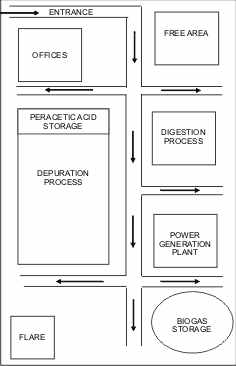
Plan of a wastewater treatment plant
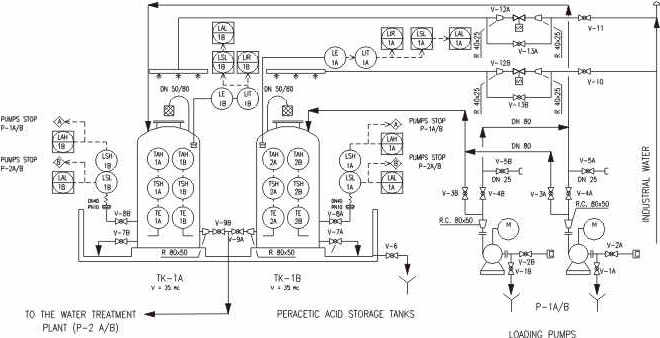
Peracetic acid drawing process
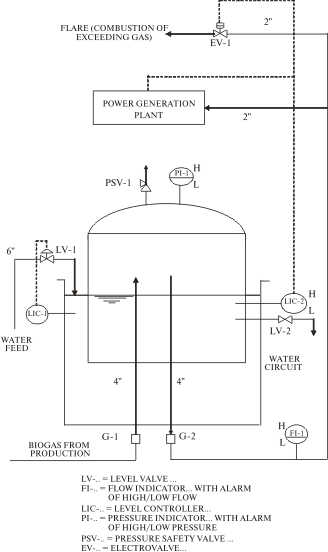
Biogas treatment drawing process
2.4. Risk quantification
2.4.1. Historical analysis
A consultation of Mhidas data bank has been carried out (updated until October
2004) in order to identify all the accidents occurred and recorded in the world,
related to the use of Peracetic acid and Biogas (methane).
Peracetic acid
The research gives only one case of accident occurred in 1998 August, 24 in
England, where a driver has been affected by weak burns related to a release
from its truck of Peracetic acid and hydrogen peroxide. The truck was in the
loading area of a supermarket, which it was evacuated for safety reasons. The
hypothesis of the causes that generated the dangerous substance release is
corrosion.
Biogas (methane)
The research results shows only two cases of accident:
• 1996 March, 23 in India: an explosion of gas occurred due to welding
operations near the biogas tank. The cause is related to the human factor;
• 2002 April, 02 in Australia: during the transfer operations of biogas to
storage, at the top of the tank a release occurred that generated a safety area
of 2 km. The cause is related to a mechanical failure.
2.4.2. HazOp and Fault trees
Peracetic acid
|
Guide Word |
Deviation |
Causes |
Consequences |
Protections |
|
Less |
Level in TK-1 A/B |
Stop of the loading pumps P-1A/B simultaneously to Peracetic acid transferring operations by pumps P-2A/B |
Decrease of the level in TK-1A/B |
Low level alarm LAL-1A/B in tanks, shown in a remote location Interlock system intervention due to low level alarm LAL-1A/B that generate the transferring pumps P-2A/B stop |
|
More |
Level in TK-1 A/B |
Simultaneously to
loading operations of the storage tanks: |
Increase of the level in TK-1A/B |
High level alarm LAH-1A/B in tanks, shown in a remote location Interlock system intervention due to high level alarm LAH-1A/B that generate the loading pumps P-1A/B stop (interlock logic A) |
|
OTHER |
Stop of transferring pumps P-2A/B |
1.
Mechanical
failure |
Increase of the level in TK-1A/B |
|
|
OTHER |
Overfilling of the tank TK-1A/B |
Increase of the level in TK-1A/B |
Release of Per acetic acid from the storage tank and filling of the containment basin |
|
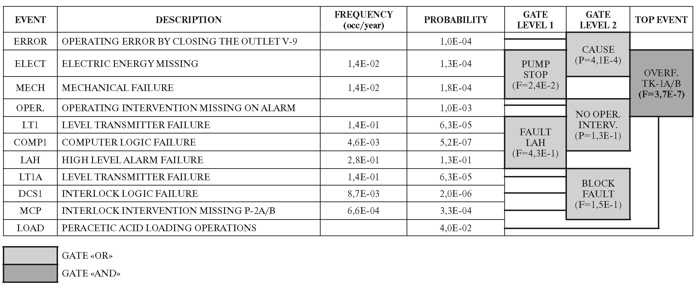
Biogas
|
Guide Word |
Deviation |
Causes |
Consequences |
Protections |
|
More |
Pressure in the biogas tank |
Failure of level controller LIC-2 with closure of electrovalve EV-1 to flare and closure of inlet valve power generation plant |
Overpressure of biogas tank and consequent gas release by G-1 and G-2 |
High pressure alarm PI-1
|
|
Low |
Level in the water tank |
Outlet water left opened
(maintenance activity) |
Level decreasing in water tank and possible biogas release |
Low level alarm in biogas tank LIC-2 |
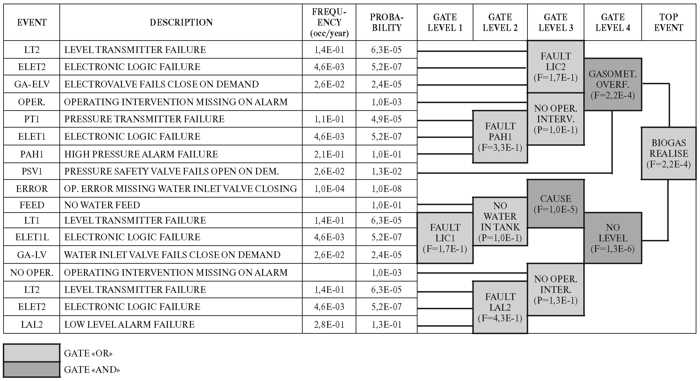
Peracetic acid
After a release of Peracetic acid, the event that can occur is the pool
generation and consequent evaporation of the product classified oxidizing.
Biogas
After a release of Biogas, the following event can occur:
• immediate ignition of released biogas with generation of a jet fire (probability
of immediate ignition: 0.1);
• delayed ignition of the biogas cloud (probability of delayed ignition: 0.1),
if the concentration of gas is included in the flammable limits of the mixture
air-biogas, with generation of the following accidental scenarios:
— flash fire, or
— explosion of the gas cloud if the amount is big and if the cloud is confined (probability
of confinement 0.01)
• dispersion of biogas without generating problems.
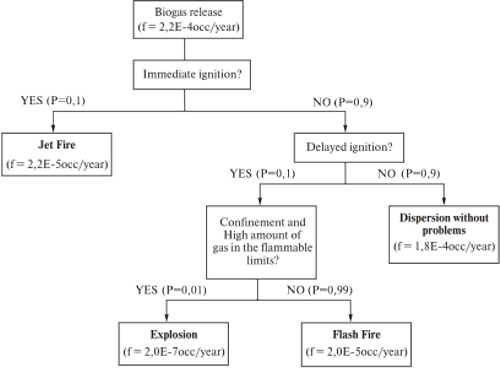
2.4.3. Consequences calculation
Peracetic acid
The absence of material that can be burned inside the containment basin of the
two Peracetic acid storage tanks is fundamental for avoiding accidental
scenarios, related to the use of Peracetic acid.
Biogas
The major effect that can be generated is related to the biogas release and
consequent delayed ignition (Flash Fire). The damage distance that can be
reached is about 400 m related to the threshold of 1/2 LFL.
2.5. Prevention, Protection and Mitigation Measures
Peracetic acid
Peracetic acid is a liquid with a flammability point included between 21 °C and
65 °C and by considering the Italian Ministerial Decree D.M. 31/07/1934 the
related category is «B». In this case specific safety distances between the tank
and the fence, warehouse, loading areas and external buildings shall be
respected.
Biogas
The biogas is a strong flammable substance and for this reason naked flames
can’t be used in the nearness. It is forbidden generate sparks and smoking. In
order to avoid explosions the area shall be ventilated and the illumination and
electrical systems shall be compatible with the classifies areas.
Torretta Vincenzo, Associate Professor of
Environmental/Sanitary Engineering, Università` dell’Insubria di Varese,
via G. B. Vico, 46, Varese, 21100, Italy. Tel. (0332) 21-87-82, fax (0332)
21-87-79. E-mail
© Íåçàâèñèìîå àãåíòñòâî ýêîëîãè÷åñêîé èíôîðìàöèè
Ïîñëåäíèå èçìåíåíèÿ âíåñåíû 21.09.08